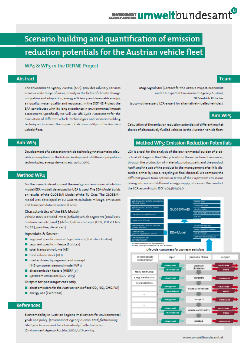Scenario Building - DEFINE
Main menu
Scenario Building
The main beneficiaries are OEI, UBA and DIW.
Scenario Building for Transport & Energy (WP4)
Embraces the development of scenarios for electromobility and its impact on the transport and energy sectors. Scenarios are developed for the vehicle technology, the European electric vehicle market and its technical potential, for the real market potential, modal split, vehicle usage patterns and energy consumption. The scenarios are developed for Austria and Germany up to 2030.
Objectives
Development of scenarios for electromobility and its impact on the transport and energy sector up to 2030
Scenarios are developed considering the development of vehicle technology (conventional and electric vehicles), the market potential of electric vehicles, potential user groups and typical vehicle usage patterns
The energy consumption of the transport sector in 2030 is derived from these scenarios. The scenarios are developed for Austria and Germany
Description
Task 4.1: Dataset on vehicle technology
PEI and UBA will develop a dataset on vehicle technology that contains plausible assumptions on the future development of different propulsion technologies up to 2030. Main focus will be on vehicles with electric propulsion, but the improvement of conventional vehicles is considered as well.
Task 4.2: Potential user groups and market potential of electric vehicles up to 2030
OEI will develop a two step approach for Germany. Based on detailed analysis of empirical, representative mobility data, possible user groups and the maximum market potential of electric vehicles can be determined. By combining the maximum potential with the results of the "Survey and Estimation of Consumer Patterns and Elasticities" from WP3for Austria and with the results from the data collection in Germany, which has already been conducted, a fututre market potential of electric vehicles up to 2030 can be determined for Germany. To apply a similar approach to the Austrian vehicle market, plausible assumptions are adopted. Some ongoing electric vehicle fleet test in Austria and Germany will be considered as well.
Task 4.3: Development of vehicle stock up to 2030
The resulkts of Task 4.2 allow a projection of the development of the vehicle stock in Austria and Germany up to 2030 for different scenarios. The projections will comprise conventional as well as electric vehicles. Starting point for the modelling of the vehicle stock is data from HEBEFA (Handbook on emission factors for road transport) and data from the German Transport Emission Model (TREMOD).
Task 4.4: Energy demand of the transport sector and additional electricity demand generated by electric vehicles up to 2030
The development of electric vehicles in Germany and Austria is complemented by assumptions on trends on the entire transport sector, including passenger and freight transport. After deriving data from different sources and complementing them with own assumptions, the total well-to-wheel energy demand of the Austrian and German transport sector can be determined. The additional electricity demand triggered by the development of electromobility is of particular concern. In order to illustrate effects on the electricity market (WP2) and to determine related emissions (WP5), load profiles with high temporal resolution are implemented.
The results are fed into the CGE model developed in WP1 and used as input for WP2 and WP7 in order to develop scenarios for the future electricity generation mix. Moreover, the results serve as input for WP5.
